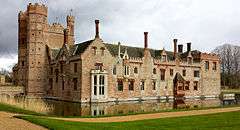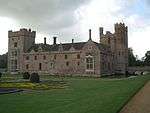Oxburgh Hall
Oxburgh Hall ("OX bru") is a moated country house in Oxborough, Norfolk, England, today in the hands of the National Trust. Built around 1482 by Sir Edmund Bedingfeld, Oxburgh has always been a family home, not a fortress. The manor of Oxborough came to the Bedingfeld family by marriage before 1446, and the house has been continuously inhabited by them since their construction of it in 1482, the date of Edward Bedingfeld's licence to crenellate.[1]
| Oxburgh Hall | |
|---|---|
 Oxburgh Hall 2014 | |
 | |
| General information | |
| Type | country house |
| Architectural style | Medieval, Moated great house |
| Location | At the village of Oxborough, 7 miles south west of Swaffham |
| Town or city | Oxborough |
| Country | England |
| Coordinates | 52°34′53″N 0°34′15″E |
| Opened | 1482 onwards |
| Owner | Owned by the National Trust |
| Technical details | |
| Material | stone and slate roof |
Description

A fine example of a late medieval, inward-facing great house, Oxburgh stands within a square moat about 75 metres on each side, and was originally enclosed; the hall range facing the gatehouse was pulled down in 1772 for Sir Richard Bedingfeld, providing a more open U-shaped house, with the open end of the U facing south. The entrance, reached by a three-arched bridge on the north side, is through a fortified gatehouse, described by Nikolaus Pevsner as "the most prominent of the English brick gatehouses of the 15th century".[2] The gate was designed to evoke the owner's power and prestige, though as fortification its value is largely symbolic; it is flanked by tall polygonal towers rising in seven tiers, with symmetrical wings extending either side that reveal nothing on the exterior of their differing internal arrangements. About 1835[3] the open end of the U was filled in with a picturesque, by no means archaeologically correct range that recreated the central courtyard. Other Victorian additions include the Flemish-style stepped gables, the massive southeast tower, the oriel windows overhanging the moat (illustration, left) and terracotta chimneys. Four towers were added to the walled kitchen garden.
The hall is well known for its priest hole. Due to the Catholic faith of the Bedingfeld family, a Catholic priest may have had to hide within the small disguised room in the event of a raid. The room is reached via a trapdoor, which when closed blends in with the tiled floor. Unlike many similar priest holes, the one at Oxburgh is open to visitors.
The hall is also notable for the Oxburgh Hangings, needlework hangings by Mary, Queen of Scots and Bess of Hardwick. Mary worked on these while imprisoned in England, in the custody of the Earl of Shrewsbury.
The estate has a number of woodland walks, including a 'Woodland Explorer' trail.
The hall is a Grade I listed building, the highest-level designation.[4]

Notes
- Nikolaus Pevsner, Northwest and South Norfolk (The Buildings of England), 1962:282).
- Pevsner 1962.
- Pevsner 1962.
- Historic England. "Oxburgh Hall (Grade I) (1342586)". National Heritage List for England. Retrieved 16 December 2014.
External links
| Wikimedia Commons has media related to Oxburgh Hall. |